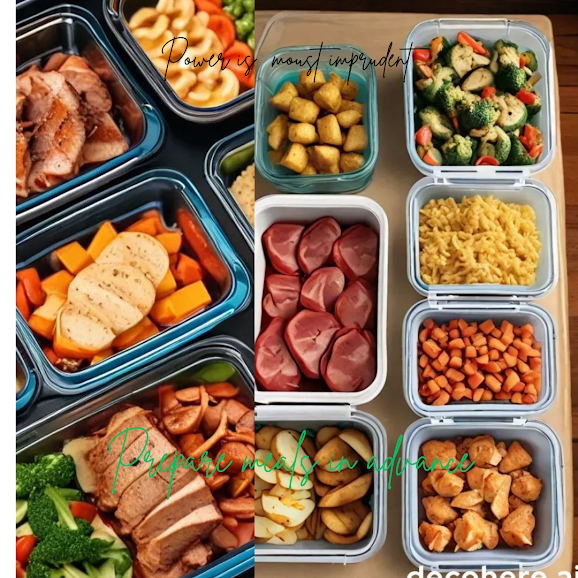Preparing meals in advance, often called meal prepping, is a game-changer for anyone looking to save time, eat healthier, or stick to a budget. By dedicating a few hours each week to cooking in bulk, you can portion out meals for days or even the entire week, ensuring you have nutritious options ready to go. This approach minimizes the temptation to grab fast food or unhealthy snacks when you're short on time or energy. For example, you can roast a tray of vegetables, grill some lean proteins, and cook a batch of grains like quinoa or brown rice, then mix and match for variety. Meal prepping also helps with portion control, as you can measure out servings in advance, which is especially useful for those tracking macros or managing dietary goals.
To make meal prepping effective, planning is key. Start by choosing recipes that hold up well in the fridge or freezer, like soups, stews, or casseroles, and invest in quality storage containers to keep food fresh. Consider your schedule and pick a day to prep—Sunday afternoons are popular for many. Write a grocery list to streamline shopping and avoid waste. When prepping, focus on balance: include a protein, complex carbs, and plenty of vegetables to keep meals satisfying. You can also add variety with sauces or spices to prevent boredom. By setting aside this time, you’re not just saving effort during busy weekdays but also giving yourself peace of mind, knowing you’re set to eat well without the daily hassle of cooking from scratch. Parson metar
Meal prepping offers a range of benefits that can simplify your life and support your health goals. First, it saves time by consolidating cooking into one or two sessions per week, freeing up busy weekdays for other priorities. Instead of scrambling to make dinner after a long day, you can just reheat a pre-made, balanced meal. Second, it promotes healthier eating habits. By planning and preparing meals in advance, you’re less likely to rely on fast food or processed snacks, and you can control ingredients to align with dietary needs, like low-carb or high-protein plans. Portioning meals also helps manage calorie intake, which is great for weight management or fitness goals.
Financially, meal prepping is a win because buying ingredients in bulk and reducing food waste cuts grocery costs. It also discourages impulsive takeout orders. Additionally, it reduces decision fatigue—knowing what’s for lunch or dinner eliminates the daily “what’s to eat?” stress. Prepped meals can be customized for variety, using different spices or sauces to keep things exciting. Finally, it supports consistency, whether you’re sticking to a nutrition plan or ensuring you have energy-boosting meals during a hectic week. With a little upfront effort, meal prepping delivers convenience, savings, and better health in one go.
Batch cooking, a cornerstone of meal prepping, is all about making large quantities of food at once to save time and effort. Here are some practical tips to make it efficient and enjoyable. First, plan your menu around recipes that scale well and store nicely, like chili, casseroles, or stir-fries. Choose dishes with overlapping ingredients to simplify shopping—think chicken, rice, and veggies for multiple meals. Invest in quality, airtight containers (glass or BPA-free plastic) to keep food fresh in the fridge for 4-5 days or freezer for up to 3 months. Label containers with the dish name and date to stay organized.
Next, streamline your cooking process. Use one-pot or sheet-pan recipes to minimize cleanup, and prep ingredients (chopping veggies, marinating proteins) before you start cooking to save time. Cook versatile bases—like a big batch of quinoa or roasted vegetables—that can be mixed and matched with different proteins or sauces for variety. Double recipes when possible, but check your pot or oven capacity to avoid overflow. To prevent flavor fatigue, portion out meals before adding seasonings or dressings, then customize when reheating. Finally, cool food completely before storing to avoid soggy textures, and freeze in single portions for grab-and-go convenience. With these tips, batch cooking becomes a low-effort way to keep your week stress-free and delicious.
Effective meal prep storage is crucial for keeping your batch-cooked meals fresh, safe, and appetizing. Start by choosing the right containers: airtight glass or BPA-free plastic containers are ideal for maintaining freshness and preventing leaks. Glass is durable, microwave-safe, and doesn’t absorb odors, while stackable designs save fridge or freezer space. For portion control, opt for single-serving containers, but consider larger ones for family-style dishes. Use clear containers or label them with the meal name and date to track freshness—most prepped meals last 4-5 days in the fridge or up to 3 months in the freezer.
Cool food completely before storing to prevent condensation, which can make meals soggy or promote bacterial growth. Divide large batches into portions to avoid repeatedly opening and closing containers, which can reduce shelf life. For freezer storage, leave some headspace in containers to account for expansion, and wrap foods like meats tightly in plastic wrap or foil before placing in containers to prevent freezer burn. Store meals in the fridge’s coldest zones (usually the back of the middle shelf) and avoid the door, where temperatures fluctuate. For reheating, ensure meals reach 165°F (74°C) for safety. With proper storage, your meal prep stays fresh, flavorful, and ready to enjoy all week.


Post a Comment